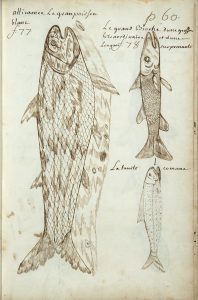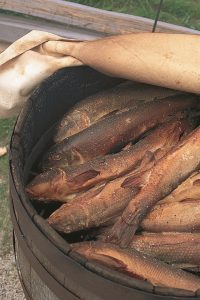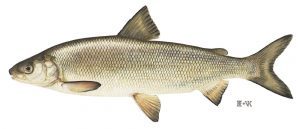“The great business of life at Mackinac was looking out upon the lake and munching the fish,
and I felt when there that I would not have the heart to look at a fish in the face for years to come.
In fact we all began to feel decidedly fishy before we left the island.”
– The Venango Spectator, October 21, 1857
Before the Straits of Mackinac became a center of international fur trade, its waters were renowned by generations of Native Americans as an abundant fishery. Of the many species in these freshwater seas, the delicate whitefish, usually weighing 3-5 pounds, was the most prized catch of all. The importance of fish at the Straits was noted early, with French Jesuit Jacques Marquette writing in 1673, “This place is the most noted in these regions for the abundance of its fisheries; for, according to the Indian saying, ‘this is the home of the fishes.’ Elsewhere, although they exist in large numbers, it is not properly their ‘home,’ which is in the neighborhood of Missilimackinac.” Whitefish are called adikameg in Ojibwe or Anishnaabemowin, effectively translating as reindeer (or deer) of the lakes.

Normally living in cold, deep water, lake whitefish spawn on shallow shoals each autumn, where they lay and fertilize their eggs. For centuries, whitefish have been widely regarded as the best-tasting and most important of all fishes in the lakes. Writing from St. Ignace in 1688, Louis Armand, Baron de Lahontan wrote, “You can scarce believe, Sir, what vast sholes [sic.] of white Fish are catch’d about the middle of the Channel, between the Continent and the Isle of Missilimackinac. The Outaouas and the Hurons could never subsist here, without the Fishery… This sort of white Fish in my opinion, is the only one in all these Lakes that can be call’d good; and indeed it goes beyond all other sorts of River Fish.” About 1695, Antoine de la Mothe Cadillac noted “the pleasure of seeing as many as a hundred whitefish caught in a single haul of a net. This is the most delicate fish of the lakes…”
Many early travelers repeated similar exultations. Although sturgeon and trout were larger, whitefish were most prized. In 1721, Jesuit Pierre Francois-Xavier de Charlevoix, the first historian of New France, wrote, “The Michillimackinac live entirely by fishing, and there is perhaps no place in the world where they are in greater plenty… the most famous of all is the white-fish; it is nearly the size and figure of a mackerel [sic.], and whether fresh or salted, nothing of a fish-kind can exceed it. The Indians tell you that it was Michabou who taught their ancestors to fish, invented nets of which he took the idea from Arachne’s, or the spider’s web.”

While French and British residents preferred domestic fare, they readily ate fish and wild game when necessary, particularly during lean winter months. In 1761, British fur trader Alexander Henry noted high prices of grain and beef “led me to be very industrious in fishing… White-fish, which exceed the trout, as a delicious and nutritious food, are here in astonishing numbers.” Having small, delicate mouths and a habit of schooling, they were most easily caught in gill nets, mainly in fall and winter. Detailing the process, Henry continued, “The white-fish is taken in nets, which are set under the ice… The fish, running against the net, entangle their gills in the meshes, and are thus detained till taken up.”
While important locally for centuries, fish at Mackinac didn’t gain economic importance until the 1830’s, when commercial fishing replaced the fur trade as the predominant industry. In his 1835 Gazetteer of the State of Michigan, author John T. Blois bragged, “The numbers, varieties, and excellent quality of the lake fish are worthy of notice. It is believed no fresh waters known, can in any respect bear comparison… Their quantities are surprising, and apparently so inexhaustible, as to warrant the belief, that were a population of millions to inhabit the lake shores, they would furnish an ample supply of this article of food, without any sensible diminution.”
 In 1836, about 1,200 barrels of whitefish and trout were taken at Mackinac. In just 20 years, the number skyrocketed to 20,000 barrels annually at the Straits, with comparable increases throughout the Great Lakes. In 1857, Mackinac’s fish-munching “Viator” wrote, “The staple article of trade is fish… These fish are taken in exceedingly deep water in what are called gill nets…The net is then sunk in 300 feet of water and left over night, when it is drawn up, and the fish are found fastened by their gills. They are then, opened and cured on the schooners, brought to the dock, inspected and barreled, when they are fit for the market. It does not add to one’s appetite for white fish, to see them piled up by cart loads on the dock, and to notice the decidedly filthy odor, that fills the whole atmosphere.”
In 1836, about 1,200 barrels of whitefish and trout were taken at Mackinac. In just 20 years, the number skyrocketed to 20,000 barrels annually at the Straits, with comparable increases throughout the Great Lakes. In 1857, Mackinac’s fish-munching “Viator” wrote, “The staple article of trade is fish… These fish are taken in exceedingly deep water in what are called gill nets…The net is then sunk in 300 feet of water and left over night, when it is drawn up, and the fish are found fastened by their gills. They are then, opened and cured on the schooners, brought to the dock, inspected and barreled, when they are fit for the market. It does not add to one’s appetite for white fish, to see them piled up by cart loads on the dock, and to notice the decidedly filthy odor, that fills the whole atmosphere.”
In his 1860 publication, Old Mackinac, Or Fortress of the Lakes, W.P. Strickland wrote, “White-fish are more highly prized than any other kind found in our waters, being the decidedly the most delicious in a fresh state, and when packed command a higher price than any other by $1 per bbl… They were once so numerous that eight thousand were taken at a single haul. At present a haul of one or two thousand is thought a very good one. In all the rivers they are growing scarce very gradually, but surely. The ratio of decrease cannot be arrived at with any degree of precision.”
The decline, recovery and future threats to Great Lakes fisheries are a long tale for another time. Restocking and other 20th century conservation efforts resulted in stabilized populations, along with efforts to restore Native American fishing rights granted by 19th century treaties. Today’s commercial fishery sustainably harvests more than eight million pounds of lake whitefish each year. Residents and guests alike continue to enjoy this humble, tasty member of the salmon family at restaurants, markets, and fisheries throughout northern Michigan.










